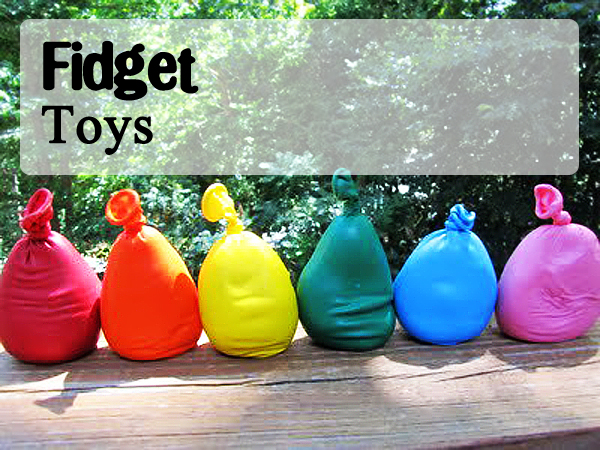Fidget Toys
You can get sets of nifty fidget toys, of all kinds and sizes and shapes, from many occupational therapy catalogs, but you can also assemble a good batch of them yourself, from easy-to-find items.
Try, for starters:
A balloon filled with sand and knotted securely
A smooth stone
A palm-size sea shell
An old set of keys
A combination lock
Oral Motor Items
Strengthening the muscles in your child’s mouth can increase speech production and decrease drooling. Anything that gives the mouth a strong sensory jolt can also improve sensory integration and make your child less likely to finger-suck or mouth objects. Try these around-the-house items to do a little impromptu oral-motor therapy.
Straw: Have your child suck something thick — pudding or yogurt are good choices — through a regular or twisty straw.
Whistle: Speech and occupational therapy catalogs sell a variety of fancy whistles, but your child can get some benefit from a plain whistle, a plastic flute, a kazoo, or one of those mini-trombone-type whistles where you pull the end of it and the sound goes up and down.
Bubbles: Blowing bubbles is good exercise for your child’s mouth. Make sure he or she actually blows rather than just waving the wand around.
Cotton balls: Hold races to see who can blow a cotton ball across a table the fastest. Have your child do it with just his mouth, and then with a straw.
Plastic necklace: Inexpensive aquarium tubing from a pet store makes a nice chewable necklace for kids who need to gnaw. Try knotting some beads in the tube for extra oomph, or putting it in the fridge for a cool bite.
Tactile Experiences
Textured toys and putties and squeezies fill the pages of sensory integration catalogs, but you have plenty of good tactile tools in your own pantry, closets, and medicine chests.
Rice: Fill a bin with rice and let your child plunge hands deep into it. Hide some toys and measuring cups for added fun. Dried beans are another good choice.
Bubbles: Blowing bubbles is good, and trying to catch bubbles is good, too. Kids who don’t like to touch stickly slimy substances may be less threatened when the stuff is bubbling through the air.
Shaving Cream: Spray some on a shower or bathtub wall and let your child fingerpaint with it.
Sand: A sandbox can be a full-body experience for a child with tactile cravings. Let your child get down and dirty with it.
Ball pits: You can buy a big inflatable pit and the balls to fill it for big bucks, but many kids’ restaurants will let your child play in theirs for as long as you want for the price of a slice or a soda. Bring a book and enjoy it while your child hits the pit and has a great therapeutic experience.
Weighted Items
Weighted blankets and vests can exert a calming influence on your child, but seeing the prices some companies charge for them can have the opposite effect on you. Whether you’re wanting to see whether weights work before coughing up all that dough; want to get a jump-start on weight benefits while you’re waiting for a professional version to be delivered; or just can’t bear the expense and want to do-it-yourself, here are five ways to improvise weighted items for your child.
Weighted blanket: Take a heavy afghan and and fold it into quarters to concentrate the weight. Put it on your child at night and see if it stops rocking, rolling, and sleeplessness.
Weighted vest: Take an old vest or shirt and fill up the pockets and hems with curtain weights. Have your child wear it during stressful times, but not constantly — it will lose its effect with overuse. Consult with an occupational therapist trained in sensory-integration techniques to determine the appropriate amount of weight for your child.
Pencil weight: Got a big box of loose nuts and bolts in the garage? Rummage through to find some nuts that will fit on the end of a pencil, then glue two or three of them around the barrel.
Weighted stuffed animal: Take an old favorite stuffed animal — but one not so favorite that your child will mind you slashing it open — and cut open paws and tummy to insert more curtain weights, nuts and bolts, or other heavy items. Sew the critter back up securely and let him sit on your child’s lap during homework.
Body weights: Catalogs sell weights for wrists, arms, even shoes. Improvise by putting some books in a backpack or weights in a fanny pack and having your child wear them when jumpy.
NOTE: Because children have different needs and different safety concerns, all these ideas should be discussed with your child’s therapist to determine the best choices, appropriate weights, and least risky alternatives.

